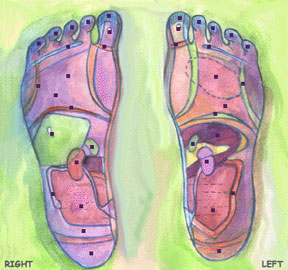

Pressure Point Therapies like Oriental Massage and Reflexology borrow from traditional Chinese and Ayurvedic medicine in that their aim is to release blockages in the flow of energies through the body. Ch'i energy meridians converge in the feet, hands and ears and many many acupuncture and acupressure points are located there. Massaging the feet and hands changes the flow of ch'i energy, which has an effect on the entire body.
Western pressure point researchers feel that because walking, hearing and manipulating objects in so important, an significant portion of the brain is used in processing bioelectrical nerve impulses from these areas. Massaging these areas releases, neurotransmitters along these nerve lines which ultimately effects other parts of the body.

Massage has been practiced in China for four or five thousand years. Amma, the Chinese word for massage, means "to calm with the hands." It was transplanted to Japan over 1500 years ago. Prior to WWII, amma was primarily massage given by blind people. Even today, half of the traditional Japanese amma practitioners are blind.
Amma includes the shiatsu techniques of direct pressure and lifting up muscle but also uses stroking, kneading, stretching and percussive movements with the thumbs, fingers, elbows, knees and feet on acupressure points. Amma masage moves out from the heart, as opposed to western message, which stresses movement in towards the heart. Like shiatsu, amma aims to rebalance the flow of ch'i energy in the meridians. Massage work is done primarily with the thumbs on specific points know as tsubos. These are the "wells" through which the meridian streams can be accessed. By breaking up congested channels and rebalancing the flow, natural healing can take place.
Tui na is similar to amma but practitioners also gently but vigorously press, push, grasp, rub, vibrate, drag, squeeze, twist and tap in additionto a rolling method using heavy wrist action.
Tui na is similar to amma because of the absence of the long, flowing strokes of western massage. A major technique of Tui na is a "rolling method" in which the back side of the hand is rolled side-to-side in hundreds of rapid repetitions over ailing areas. A flowing motion is created as the practitioner moves their rolling rhythmic hands along the torso or appendages like a wave rolling over the ocean. These quick movements stimulate the energy at the acupuncture points and move it along like water in a stream.
A typical tui na treatment session consists of a series of these very rapidly performed techniques lasting from 20 to 30 minutes. It is said to be effective for bruises, sprains and breaks because when there is an injury to the body, ch'i energy stagnates there, the blood does not move and pain is created. By working the acupuncture points, the ch'i gets moving again.
Shiatsu, from the Japanese word "shi," meaning finger, and "atsu," meaning pressure, is the combination of many different techniques for applying pressure to points along the ch'i energy meridians. The practitioners use their fingers, hands, knees, elbows and sometimes feet to cover several critical points simultaneously.
In addition to pressing, hooking, sweeping, shaking, rotating, grasping, vibrating, patting and pinching, the practitioner uses a gentleness, fluidity and rhythmical motion to work with the imbalances in the patient's ch'i, creating a constant motion and unique rapport between the practitioner and patient. This "dance" uses the power of touch to awaken the client's own self-healing powers, ultimately giving them the knowledge and ability to balance their own ch'i energies. Thus, the giver is the receiver and the receiver is the giver.